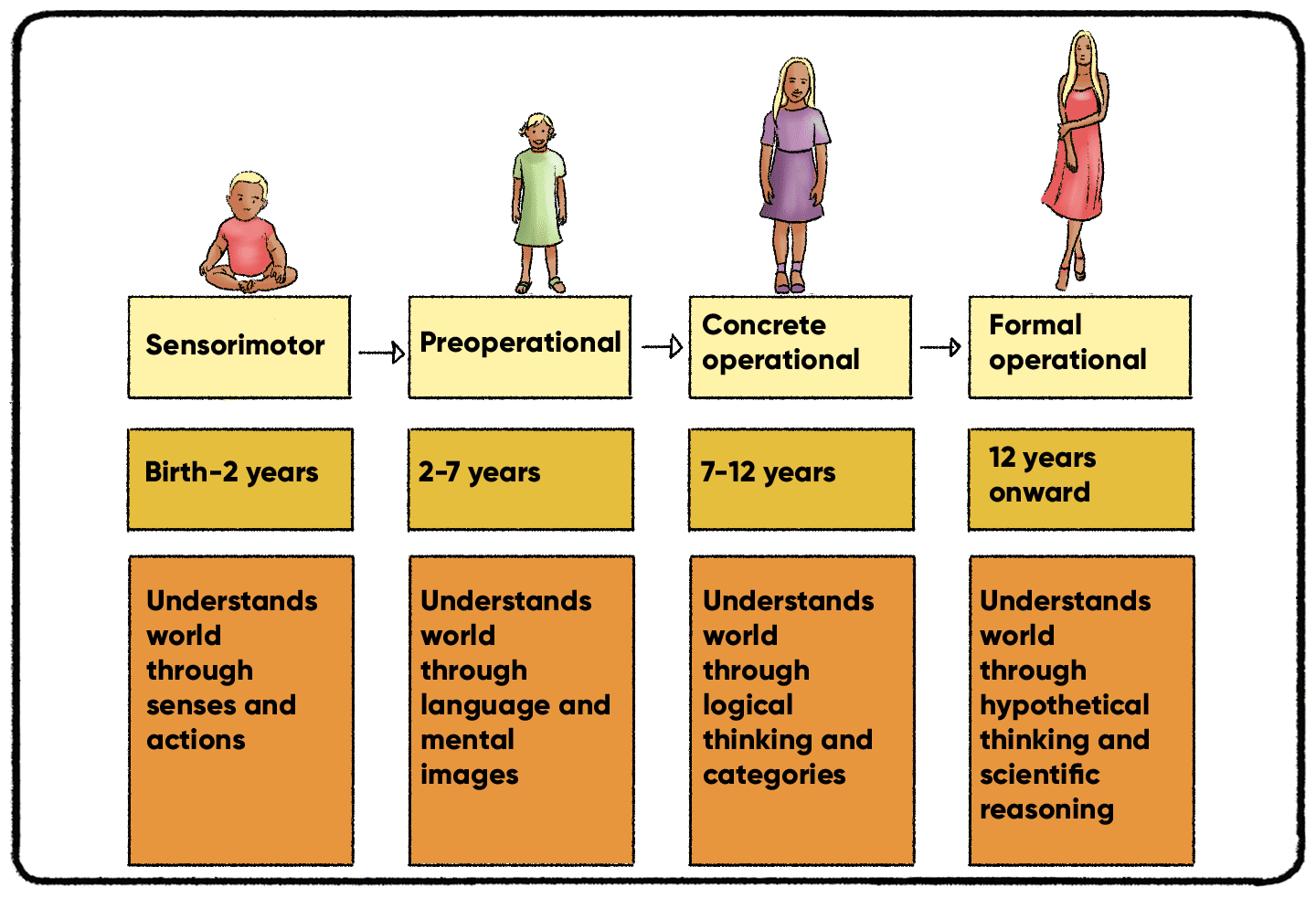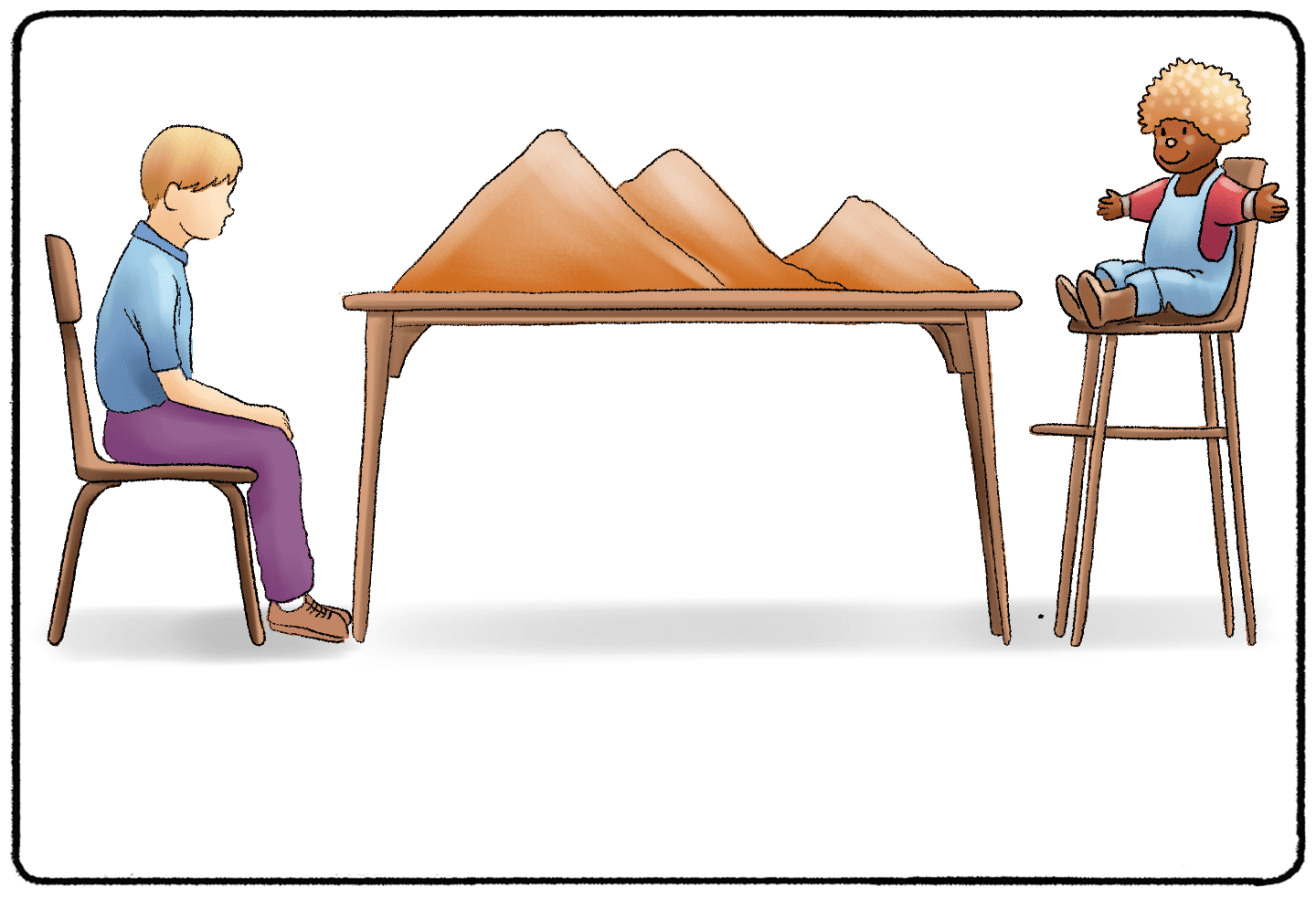When a child reaches age 2, their minds start to develop rapidly. It seems like they are learning something new every minute and continuing to build on the things they have learned in the past. At this age, psychologist Jean Piaget theorized that they entered a new stage in cognitive development: the Preoperational Stage.
Here, we’ll talk about what happens during the Preoperational Stage and the most important milestones children hit.

What Is the Preoperational Stage?
The Preoperational Stage is also known as the early childhood stage. It lasts between 2-6 years old. Some of the highlights of the Preoperational Stage include:
- Developing symbolic play and thought
- Developing language
- Understanding Conservation and empathy
Conservation
During the first few years of their life, children build a lot of schemas to help them understand the world. But simply building individual schemas can’t always tackle complex problems. We need to combine or integrate different schemas to assess the world around us. Children start to develop this ability during the Preoperational Stage.
As they start to combine different schemas, they begin to understand Conservation. I’m not talking about conservation in an ecological sense. I’m talking about how some properties are conserved even as an object transforms physically. Piaget used “The Cup Test” to explain when and how children develop this schema.
In The Cup Test, children are shown two identical glasses filled with the same amount of water. The child can understand that there is the same amount of water in both glasses. Then, the researcher presents two glasses (one tall and skinny, another short and wide) with the same amount of water in both glasses. If the child has not developed the idea of Conservation, they are likely to guess that the taller glass contains more water.
The child can understand that a taller glass can fit more water than a shorter glass. They understand a wider glass can fit more water than a skinnier glass. However, they cannot integrate the two schemas and assess how to determine the right amount of water in both glasses.
Other examples of conservation include a ball of clay that has been smashed or a row of symbols that has been stretched out. Without the principles of Conservation, the child cannot fathom that the researcher has not added more clay to the pile or symbols to the line.
Pretend Play
Playing “pretend” is a pivotal aspect of a child's cognitive development during the Preoperational Stage. As children engage in make-believe games, where they might role-play as a parent, a teacher, a superhero, or mythical characters like a princess or a dragon, they actively enhance their understanding of the world around them. Using everyday objects as props, such as imagining a broomstick as a gallant steed or a cardboard box as a formidable fortress, illustrates their budding ability to substitute one thing for another in their mind – a key indicator of symbolic thought.
This concept of pretend play stems from the broader domain of symbolic play. As children navigate through the preoperational stage, they understand and appreciate symbols. They recognize that certain symbols, shapes, letters, or objects can represent something else. For instance, the alphabet becomes more than just random characters; each letter symbolizes specific sounds that, when combined, form words. By age 6, with this foundational grasp of symbolic representation, children begin to interpret and understand symbols in diverse contexts, from reading a storybook to recognizing that a stop sign means vehicles must halt.
Symbolic thought and symbolic play are paramount during the Preoperational Stage as they facilitate a deeper cognitive connection between abstract concepts and tangible entities. This process boosts imaginative capacities and underpins essential skills such as problem-solving, abstract thinking, and language development. By engaging in symbolic play, children are laying down cognitive pathways to help them make sense of, interact with, and influence their world more effectively.
Egocentrism
Children learn how to play pretend during the Preoperational Stage, but they ironically have a hard time seeing things from other people’s points of view. Piaget theorized that children were still very egocentric during the Preoperational Stage. This means they cannot empathize or see things from another person’s point of view. When a parent tells a child that they have to share a cookie so that their brother can eat, the idea that the brother may also want a cookie may go over the child’s head.
Piaget assessed this development through the Three Mountains Task. The task involves a doll and a model of three different mountains. After a period of letting the child observe the model from all sides, the doll is placed in front of the model. Piaget asked children to choose the view from which the doll could see the mountains.
This task was meant for children to place themselves in the doll’s shoes. From this test, Piaget theorized that children were egocentric until age 7. At this point (as they enter the Concrete Operational Stage,) the child can begin to see things from other people’s perspectives.
Policeman Doll Study
While Piaget's contributions to the understanding of cognitive development have been monumental, they have also been the subject of critique. One frequent point of contention has been his portrayal of children's capabilities during the Preoperational stage. Many felt that Piaget overly emphasized children’s limitations during this phase, suggesting that they lacked abilities such as empathy, understanding conservation, and so on.
One particular point of debate was Piaget's "Three Mountains Task" from 1956, intended to illustrate the egocentrism of children during the Preoperational stage. Critics argued that the task was too complex and might not genuinely capture the children’s cognitive abilities. They felt that the task's design, requiring children to select from photographs to represent a 3D model's view, was potentially misleading and might have undervalued children's true cognitive skills.
This concern set the stage for Mark Hughes' intervention in 1975. Hughes believed that a more straightforward and intuitive experiment was necessary to assess when children transitioned out of egocentrism accurately. Hence, he devised the "Policeman Doll Study."
This experiment presented children with a model featuring two intersecting walls and a policeman doll. Positioned behind one wall, the policeman's view was obscured, and children were tasked with determining where a doll could be placed so it remained hidden from the policeman. Hughes provided children with thorough instructions and feedback throughout the experiment to ensure clarity.

The results were illuminating. Contrary to the conclusions drawn from Piaget's Three Mountains Task, many children, even those under the age of 7, successfully deduced the doll's best hiding spots, showcasing their ability to perceive situations from perspectives other than their own. Their competence was further demonstrated when a second policeman doll was introduced, and they still effectively identified the doll's ideal hiding places.
Hughes' study had significant implications for the field. It suggested that children's cognitive abilities during the Preoperational stage might be more advanced than Piaget initially theorized. Furthermore, it highlighted the importance of ensuring that experimental designs genuinely reflect the cognitive processes under scrutiny without inadvertently introducing confounding factors. In essence, Hughes' Policeman Doll Study underscores the idea that foundational theories, like those of Piaget, are instrumental in shaping our understanding. However, they must also be receptive to refinement and evolution as newer, more nuanced research emerges.
The Turntable Task
Another study in 1975 confirmed these results. Instead of giving the child a stationary model, The Turntable Task implemented a turntable. Participants were given one still model and another that they could turn around. After the participants had time to look at the model from different angles, they were given a doll to look at from a specific vantage point. Researchers then asked the children to spin the model on the turntable until their vantage point matched the doll.
The results were similar to the Policeman Doll study - children who were four (and even three) could complete the task successfully.
Conclusions
What does the evolution of the Theory of Cognitive Development say about psychology? That’s not perfect on the first try. While Piaget is still regarded as one of the most influential psychologists in cognitive development, psychologists have found ways to change his experiments and paint a more accurate picture of how children develop.
